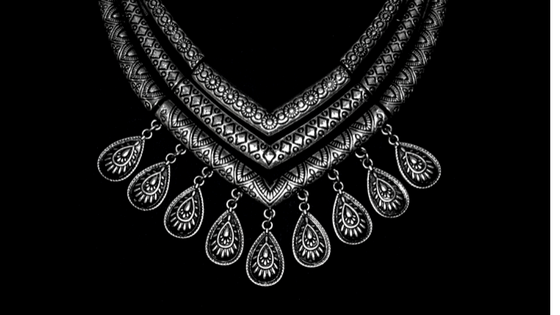I recently took some “me time” to visit the Italian Jewels: Bulgari Style exhibition at the NGV International here in Melbourne. I was there to take a break from the everyday, spend an hour marvelling at the beauty and craftsmanship, to indulge in a little bit of fantasy and escapism; I didn’t expect to glean so many valuable business lessons from the exquisite jewels and the celebrities they adorned.

Italian jewellery house Bulgari, together with the National Gallery of Victoria, has created a world first display of film, photography and glittering jewels. Never before has a collection like this travelled the world, featuring dazzling items from the personal collections of Hollywood stars including Elizabeth Taylor and Gina Lollobrigida as well as from the design house’s own archives. The pieces are displayed alongside photographs and film clips of the stunning movie stars who wore them both on and off screen, together with historical details from the design house.
Instead of switching off and losing myself in the life and times of Bulgari, I found myself absorbing these business insights from one of the world’s most successful and luxurious brands:
- Do one thing and do it well before expanding
- Collaborate with an attitude of abundance
- Respond and adapt to your customers’ requests, but stay true to you
- Be flexible and Repurpose your content
- Preparation, preparation, preparation
- Appreciate the work even if it is not your style
- Perservere
Do one thing and do it well before expanding
Bulgari’s signature aesthetic is its use and combination of coloured gemstones. Its distinctive style emerged in the optimism of the post-war years as Italy developed an international reputation for innovative design and craftsmanship. Bulgari selects gemstones that reflect the colour and texture of the Mediterranean landscape and its designers bring precious and semi-precious stones together in unexpected combinations creating vibrant, colourful, unique pieces that come to life when worn.
Even when the jewellers started to add new styles, techniques and items to their collections, the Bulgari aesthetic remained one of colour and texture, always reflecting its Mediterranean heritage.
Collaborate with an attitude of abundance
When you focus on doing one thing and doing it well, it naturally follows there are things you are either not doing, or not doing well. Early in our business journey many of us try to “do it all” with varying degrees of success. House Bulgari has long taken the path of collaboration instead, living the philosophy that there is enough for everyone, even inviting a rival to get involved with this current exhibition.
Respond and adapt to your customers’ requests, but stay true to you
One thing that really struck me is how slowly the design house changes or ads to its range. Bulgari introduces a new design line more or less once every decade. In the 1940’s Bulgari’s innovative designers embraced a unique process, known as Tubogas, in which the flexible tubular band of precious metal is manufactured without soldering. The delicate process was developed in the second half of the nineteenth century, and revived by Bulgari in the 1940s with the first serpenti bracelet-watch which subsequently became one of its trademarks.
“During the early 1960s, Bulgari turned away from traditional French design formulas and began developing a fresh, distinctly Italian identity with its designers. Greater emphasis was placed on taut, geometric designs and streamlined contours that embraced the marquise and cabochon cuts. Reviving an experimentation first instigated in the 1930s, Bulgari began using the cabochon cut, a rounded and polished treatment, for coloured stones placed in prominent positions, giving jewels volume and height. It was a cut usually reserved for opaque semi-precious gems, but Bulgari championed its use for transparent precious stones to create bold and visually striking designs.” ~ Exhibition notes
In the 1970’s Bulgari created a range of luxurious evening bags, known as Melone, that invoked 1920’s style. The style became so popular there was soon a waiting list for these evening clutches that at the same time both reflected the brand’s history of luxury jewels and introduced a new, innovative way to wear precious stones and materials.
The 1970’s also saw the re-imagination and re-introduction of the Sautoir.
“The sautoir is the ultimate statement of elegant sophistication. It refers to a long necklace, often with detachable pendant or tassel, and developed during the Art Nouveau period at the turn of the century. Following the Second World War, the sautoir went out of fashion until re-emerging in the 1970s in response to more casual fashion trends. Women were now looking for sophisticated jewels that could be worn from morning to night, and Bulgari responded by producing a wide range of designs that were bold and experimental.” ~ Exhibition notes
On their face, these new products represented a bold shift in style and aesthetic; but in each case, the house was reinterpreting and reimaging items from its own archives. The selection and combination of materials remained consistent to the brand’s core aesthetic, enabling Bulgari to give its customers what they wanted, while remaining true to its central identity.
Be Flexible and Repurpose your Content
One of my favourite piece in the exhibition was the platinum and diamond convertible necklace – and not just because it was so dazzling. This set can be worn as a necklace and bracelet, or the pieces can be connected to form one longer necklace. I love the versatility and flexibility of this piece and other similar pieces in the exhibition, such as the tiara that can also be worn as a necklace. Elizabeth Taylor owned an emerald brook which did double duty as the pendant on a stunning jewelled collar necklace; this emerald suite (gifts from Richard Burton), along with matching earrings, were reportedly among the actresses favourite jewels, and there are many photos of her wearing them at various events. In fact, Taylor’s love affair with Bulgari was the most constant and faithful of all her love affairs. She is reported to have negotiated hard to keep all her Bulgari jewels in each of her divorces, and Richard Burton joked that during the nine months she was in Rome filming Cleopatra, she learnt only one word of Italian: ‘Bulgari’.
Preparation, preparation, preparation
We all know it is important to prepare carefully and thoroughly for any business venture, and we have all taken short cuts in the preparation phase from time to time with varying degrees of success.
Preparation is vital for a healthy, successful business, and this is also a key pillar of the Bulgari way of doing business. In their remarks at the opening of the exhibition, the curators noted it had taken over three years to arrange this exhibition – three years for a display that is open for only four months!
Appreciate the work, even if it’s not your style
As mentioned earlier, Bulgari’s designers breathed new life into the tubogas method when they created the serpenti bracelet-watch, which remains popular decades later. “In around 1965 this was translated into a more realistic interpretation of the serpent, featuring numerous separate elements simulating the reptile’s scales, and with a timepiece concealed in a hinged, bejewelled snake’s head.” ~ Exhibition notes. The serpanti line expanded to include belts that do double duty as rope necklaces, the most recent example of which in the exhibition was produced in 2010. The serpent jewellery was championed by Diana Vreeland during her tenure as Editor of US Vogue, and yet, I don’t like them. I can appreciate the beauty of the workmanship and the innovation of its creation, but as a piece of jewellery I find them vulgar; and that’s ok, I can appreciate the work that has gone into the serpanti without ever aspiring to wear one myself.
Persevere
The Bulgari story is one of innovation, iteration and success. In 2017, Bulgari celebrates its 133th anniversary. Founded in 1884, the brand has grown from a single jewellery store to one of the world’s leading luxury labels, with its creations featured on film, worn by stars, and exhibited internationally.. Those of us not running an internationally acclaimed luxury jewellery house could do worse than to follow Bulgari’s lead, and learn a few lessons from its approach to business and to life; Bulgari is, after all, the very epitome of La Dolce Vita.
Italian Jewels: Bulgari Style will be on display at the NGV International until 29 January 2017. Open daily, 10 am – 5 pm. Entry is free.





















